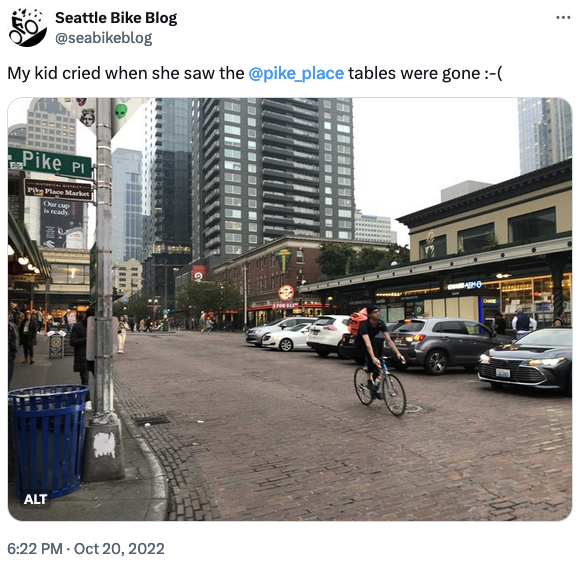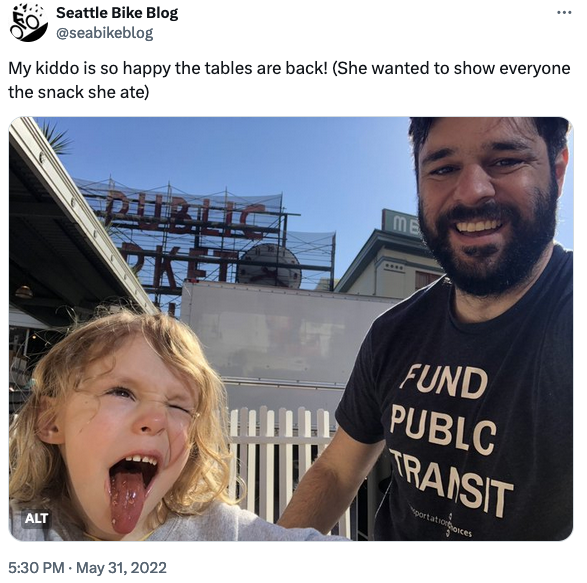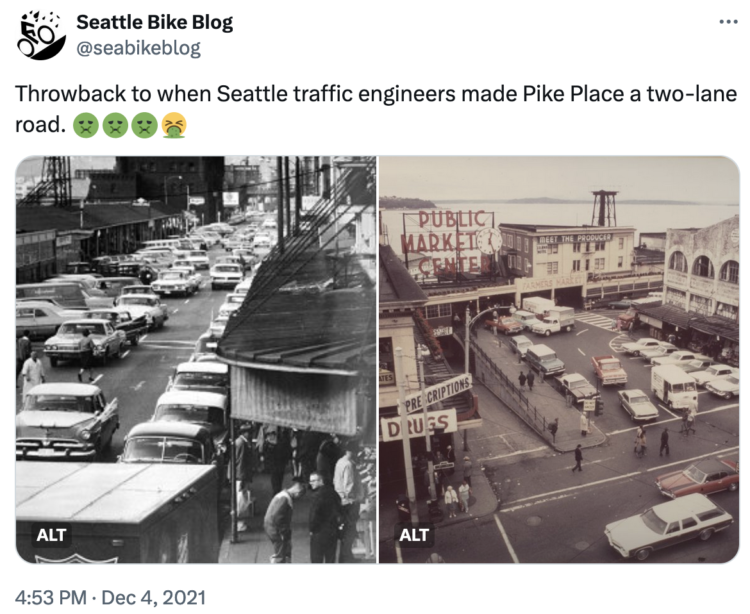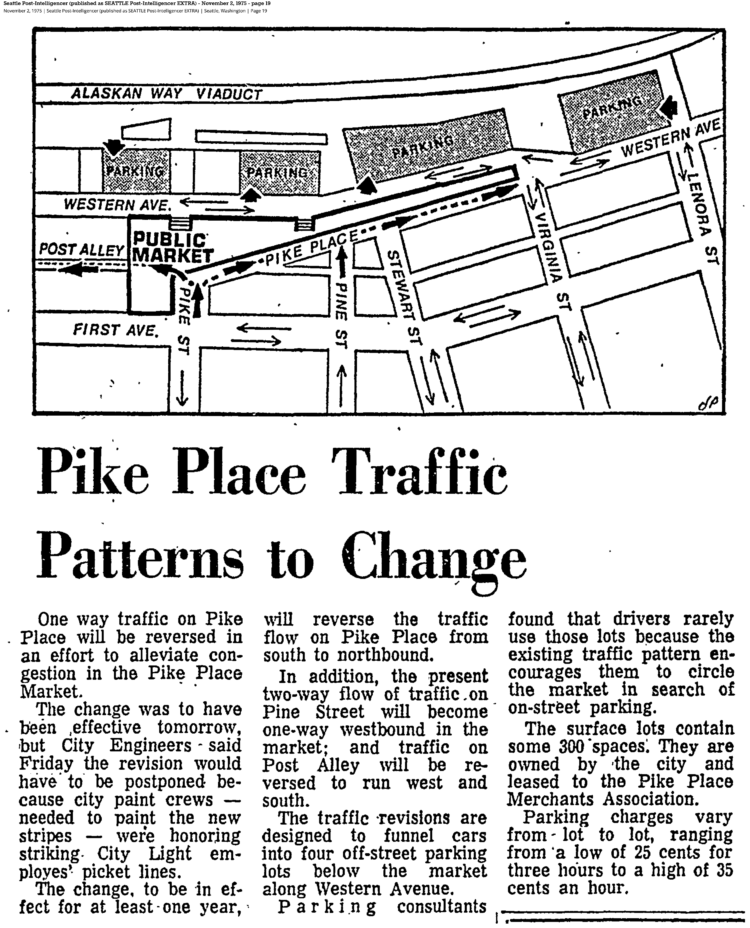Pike Market Preschool family calls for a car-free (or at least tourist-driver-free) Pike Place
My child attended the truly amazing Pike Market Child Care and Preschool for three years before graduating in summer 2023. We biked there every day together. Navigating the market is second nature to her. She knows all the shortcuts and how to find every store (well, every store with candy, magic, or toys). Her allowance played a major role in propping up the market's fortune teller machine industry during those tough early pandemic years.
She cried the day that the on-street picnic tables disappeared at the end of summer because that is where we would sit to eat an after school snack every day, whether it was a brownie from Three Girls or those sugar donuts or something from Rotary Grocery. She didn't understand why they would take away a place where we could eat just so a couple people could park cars. I don't understand, either.

But then she was so happy when they returned the next spring.

She also loved the rare days that the street was closed to cars because she didn't need to hold my hand to walk in the street. The lack of cars gave her freedom to move around the market she loves so much without fear. This was a powerful experience for her.

Most car drop-offs and pick-ups for the preschool happen on Western Ave, not Pike Place. These parents aren't fools. I was surprised to read in Publicola that Heather Pihl of Friends of the Market cited the preschool and child care as a reason to keep cars on Pike Place and example of why the street is not a place to hang out." Why are people playing music if this is not a place to hang out? Are we not supposed to stop and listen? People buy prepared food from vendors and want to start eating it as they step away from the counter. Why not make it easy and comfortable for them to do so? The picnic table area at the Marketfront is cool (if you can find it), but it's a very different vibe. People love to hang out on Pike Place. It's good for business, it's good for patrons, and it's good for the city. Why fight it?
I was surprised to see Councilmember Bob Kettle step in it recently by proposing an amendment (PDF) to the Seattle Transportation Plan that would all but block funding for a Pike Place event street" capital project (#65 in this PDF) that prioritizes people walking and rolling around Pike Place while enabling efficient and reliable delivery of goods and access to Pike Place Market. This could include redesigning the street to make it more enjoyable for pedestrians and restricting access for people driving at certain times." The response from the public was swift and overwhelming. As of press time, over 14,000 people have signed letters have been sent through an online petition asking Seattle leaders to protect the Pike Place project, which is about double the total number of comments received through SDOT's online engagement portal for the entire Seattle Transportation Plan back in phase 1 of outreach in 2022. (CORRECTION: We initially reported that 14,000 people had sent letters when in fact about 14,000 letters had been sent by about 1,555 people. We regret the error.)
The Market has a long history of making bold changes to this street. Perhaps they have done such a good job of rebuilding the historic look that many people are not aware this was once a multi-lane asphalt through-street:

Reversing the flow of traffic was initially done in 1975 as a year-long experiment," and it went well enough that we have stuck with it ever since. News reports at the time note that they only did this to direct people to Western Ave parking garages and get them to stop circling the market looking for parking. People are still circling the market looking for parking, and we have better ways to get people to the parking garages than through the middle of the now much busier market. This road is not in some historic condition that we can't touch without ruining the careful balance of the market. We tried something in the 1970s, it worked a little better, so we kept it. We can and should keep trying new things to keep improving the experience in the market generation by generation.
 From the November 2, 1975, issue of the Seattle P-I.
From the November 2, 1975, issue of the Seattle P-I.Back in the 1960s and 70s, the so-called urban renewal" plan for Pike Place called for replacing a bunch of buildings with a 900-stall parking garage and turning Pike Place into a car-free promenade along with redevelopment of many of the market buildings into something more akin to an suburban mall of that era. A half century ago, fighting to maintain traffic on Pike Place was part of the fight against the mallification of the market. The market should be part of the fabric of the city, not an island of commerce within it. Compare the bustle of Pike Place to the ghost town inside Pacific Place a few blocks away, and its clear that the market philosophy got it right. I get the sense that people may still be fighting that same battle today, but this is completely different. Our city has changed a lot since the 1970s. Today, most people get to downtown destinations by walking, biking and taking transit, not by car. A car-free (or at least tourist-driver-free) market is a response to people's desire for the market to fit even better into our city's current urban fabric, which has moved on from a mid-century overreliance on cars and has aspirations to continue doing so.
Perhaps decisionmakers and market leaders can do a little experiment for themselves. Instead of prioritizing the view of the market through the windshield of an adult in a car, try seeing Pike Place from the perspective of a preschooler who loves this place more than any other place on earth. Sit on a curb so your eyes are level with a child's and look at how much more menacing those cars are. Watch parents keep an iron grip on their kids' hands to stop them from gleefully running ahead through traffic to climb on Rachel the pig or stare at the rainbow cookies in the Three Girls Bakery window. It doesn't need to be this way.
Allowing confused tourists to drive their rental SUVs down Pike Place does nobody any good. We are capable of finding solutions for deliveries and loading and accessible parking without also allowing confused tourists. Of all the actually difficult challenges facing our city, this isn't one of them.